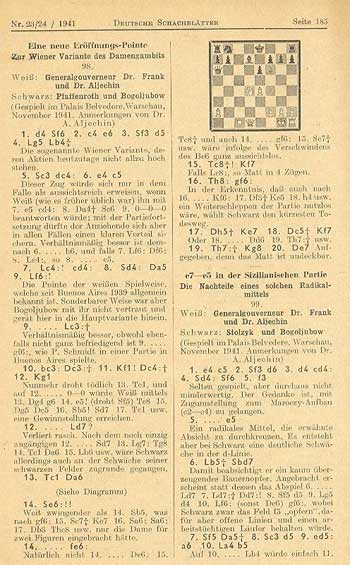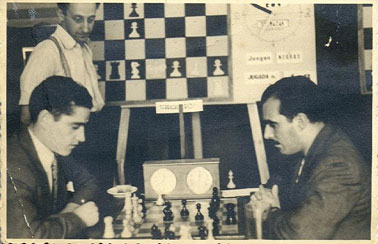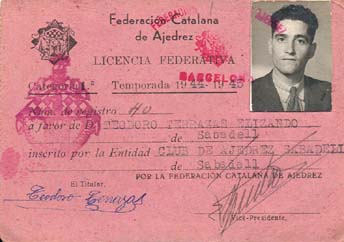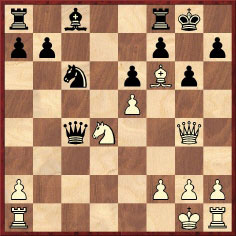Unsolved Chess Mysteries (3)
By Edward Winter
Miquel Artigas (Sabadell, Spain) kindly presented in Chess Notes (C.N.s 4008 and 4015) six photographs discovered in the archives of the Club d’escacs Sabadell. All were taken in August 1945, during a little-known tournament in Sabadell won by Alexander Alekhine and, unexpectedly, two of the pictures (below) have given rise to curious mysteries.
Below is the crosstable of the tournament, from page 225 of Alekhine’s book ¡Legado! (Madrid, 1946):

Mystery one: the alleged Alekhine v Muñoz miniature

Click to enlarge
In C.N. 4016 we commented that from the identification of the players at the bottom of the demonstration board it seemed clear that Alekhine was facing Muñoz but that the position bears no relation to the game between those two players as presented on pages 231-233 of A. Alekhine Agony of a Chess Genius by P. Morán (Jefferson, 1989). Nor were we able to match the position with any other game. The game-score given by Morán as Alekhine v Muñoz was as follows:
1 d4 d5 2 c4 e6 3 Nf3 Nf6 4 Bg5 Bb4+ 5 Nc3 dxc4 6 e4 c5 7 Bxc4 cxd4 8 Nxd4 Qa5 9 Bxf6 Bxc3+ 10 bxc3 Qxc3+ 11 Kf1 Qxc4+ 12 Kg1 O-O 13 Qg4 g6 14 e5 Nc6
15 Nf5 Resigns. [Click to replay]
The same 15-move game was also presented as Alekhine v Muñoz on page 728 of Alexander Alekhine’s Chess Games, 1902-1946 by L.M. Skinner and R.G.P. Verhoeven (Jefferson, 1998), but the source specified there was merely Morán’s book. The Spanish edition of the latter was published in 1972, and the 15-move game has yet to be found in any previous source.
In C.N. 4357 Leonard Barden (London) made a number of comments, including the following:
‘The real encounter between Alekhine and Muñoz, which must be the pictured game, looks like a French Defence with 3 Nd2/Nc3 dxe4 4 Nxe4. In his game against Julio López in a tournament at Almería later the same month Alekhine chose a rather similar formation to that shown in the photograph, and especially Bf4 with Bg3 after Black’s Nd5. The black formation in the picture is indistinct, but Muñoz has gone for ...a6 and perhaps ...Bd7 rather than the ...b6/Bb7/Re8 set-up which encouraged Alekhine’s sacrificial king’s-side attack in the López game.
The Skinner/Verhoeven book on Alekhine records that his game against Muñoz was played in the ninth and final round, on 10 August. Tournament photographers often turn up on the first day or the final day, so that is consistent too.
But in that case, who was the loser of the 15-mover? 14 e5 is essentially just a one-move cheapo based on Black missing the obvious Nf5 threat. ... The database shows 14 Qf4 as the normal continuation, with Trifunović v Gligorić, Mar del Plata, 1953 as a principal example. So 14 e5 looks like the kind of move that is played in a simultaneous exhibition or, if in a tournament, against a truly weak player.’
Mr Barden presented a further detailed analysis in C.N. 4394:
‘It is ... absolutely sure that the Alekhine v Muñoz photograph of the French Defence game is from round nine, after about one hour’s play, as shown by the clocks, and that the 15-move game cannot have been played between those two players in the Sabadell tournament ...
On the face of it, the 15-mover would have to be either Alekhine v Pérez or Alekhine v Ros, which are the two missing games which he won as White.
The only other known game by Alekhine in his entire career which opens 1 d4 d5 2 c4 e6 3 Nf3 Nf6 4 Bg5 Bb4+ (most other opponents played 4...Nbd7) appears to be the consultation game Alekhine and Frank v Bogoljubow and Pfaffenroth, Warsaw, 1941. It varied from the 15-mover with 12...Bd7? 13 Rc1 Qa6 14 Nxe6 fxe6 15 Rc8+ Kf7 16 Rxh8 gxf6 17 Qh5+ Ke7 18 Qc5+ Kf7 19 Rf8+ Kg7 20 Qe7 Resigns. See pages 670-671 of Skinner and Verhoeven’s book. The game was also given by Morán in his notes to the 15-mover which he incorrectly headed Alekhine v Muñoz.
In his annotations to the consultation game on page 185 of the 1 December 1941 issue of Deutsche Schachblätter Alekhine commented that “after 12...O-O White would obtain a winning position by means of 13 Qg4 g6 14 e5! (threatening Nf5)”. In other words, the 15-mover had essentially appeared four years earlier.

Click to enlarge
During his last five years Alekhine normally played 1 e4, mainly reserving 1 d4 for selected stronger opponents. Then after 1...Nf6 2 c4 e6 3 Nf3 Nf6 or b6 he would go into a Catalan or Queen’s Indian. So would a lesser player like Pérez or Ros choose, as Black, an obscure system with such a dubious reputation four years later in Sabadell, and why should Alekhine choose 4 Bg5 rather than his usual 4 g3 against a random opponent when he was not to know that the game would go down the Vienna Variation route?
I met Francisco Pérez (who died in 1999) at the 1958 and 1960 Olympiads, at which time he was a strong and ambitious International Master. Later he emigrated from Spain to Cuba, where he could play on a high board, become the national trainer and compete in the Capablanca Memorial tournaments in Havana. He was theoretically up-to-date in the King’s Indian, which he used in 1958, and I find it hard to believe that he would have tried to surprise Alekhine with a rare dubious line and then fallen into a one-move trap.
In the meeting between Alekhine and Ros one would expect 1 e4 by Alekhine (against a weak opponent) or, if 1 d4, a Catalan. And if Ros really knew enough to choose the sharp Vienna Variation he might be expected to know the above-mentioned consultation game. In the 15-mover Black’s play is both too strong (knowledge of a sharp theoretical line) and too weak (the worst possible move was played at the first opportunity). 14...Nc6 (the only independent move in the 15-mover) is really bad, as it allows not only 15 Nf5 but also 15 Nxc6, after which 15...Qxg4 permits 16 Ne7 mate and if 15...Qxc6 then 16 Qf4, followed by Qh6-g7. It is also worth mentioning that the consultation game was given on pages 230-231 of Schachgenie Aljechin by H. Müller and A. Pawelczak (Berlin-Frohnau, 1953), with a note at move 12 which included the line 12...O-O 13 Qg4 g6 14 e5 Nd7 15 Qf4 Nxf6. However, 14...Nd7 is answered by 15 Nf5. The German book was obviously unaware of Alekhine’s annotations in Deutsche Schachblätter, which is surprising as Müller was a well-known theoretician. However, the book’s other suggested reply to 14 e5 is 14...Re8, which creates a hole for the black king at f8 and therefore stops the 15 Nf5 trick.
Of course, if Alekhine won the 15-mover against neither Pérez nor Ros that means that it was not played by him in the Sabadell tournament at all. There is also the dog that failed to bark in the night argument. It has not been shown that “Alekhine v Muñoz” appeared in print before the original Spanish edition of Morán’s book in 1972, yet other Alekhine miniatures from the war years were published in contemporary sources. Alekhine, in 1945, badly needed to improve his public image following the anti-Semitic articles controversy. How better to do so than by a 15-move queen sacrifice game (never mind that it was analysis) which every space-limited chess journalist the world over would pounce on? But Alekhine himself, his publicist Lupi, who was present, Medina, who was a chess journalist and was also present, and the Sabadell organizers all kept silent. In particular, the game did not appear in Alekhine’s book ¡Legado!, which, indeed, had no games from the event. So was the game ever played, or did somebody merely create it from Alekhine’s annotations to the consultation game in Deutsche Schachblätter?’
Mystery two: which Terrazas?
The other photograph submitted by Miquel Artigas from Sabadell, 1945 which has given rise to a mystery is the following:

Terrazas v Ros – click to enlarge
In C.N. 4008 we expressed puzzlement at the picture of Terrazas, because on page 227 of the English edition of Pablo Morán’s book on Alekhine the translator, Frank X. Mur, added the following note at the end of the Terrazas v Alekhine game:
‘Alekhine’s victim was 11 years old. Years later he wrote: “I only recall that the imposing figure of an Alekhine made one play with a deep reverential awe, especially at that age.” – Filiberto Terrazas to Frank X. Mur, letter dated 19 January 1979.’
So was Terrazas an adult or a child? C.N. 4015 mentioned that the original (1972) Spanish edition of Morán’s book gave no forename, or even initial, for Terrazas and asked whether he was really Filiberto. (A player of that name certainly existed.) Mr Artigas wrote in that same C.N. item:
‘In Sabadell there was a player named Teodoro Terrazas Elizando. In the 1944-45 season he was registered with the Federación Catalana de Ajedrez as a first-category player for the Sabadell club, and I have been lucky enough to find his identity card for that season.’

Subsequently (C.N. 4392) Mr Artigas reported that the local newspaper of the time, Sabadell, referred to the participant as Teodoro Terrazas Elizando, a local player, but in C.N. 4665 Frank X. Mur (Oakland, CA, USA) expanded on his grounds for having identified Black as Filiberto Terrazas:
‘After Koltanowski published the Terrazas v Alekhine game, stating that the former was aged 11 in 1945, I asked him to give me the address of Terrazas, who was an expatriate in Mexico. Koltanowski did so, and Terrazas’s reply to me of 19 January 1979 included the following two sentences, the second of which was translated into English on page 227 of A. Alekhine Agony of a Chess Genius:
“Como con toda razón expresa Usted, a los 11 años de edad yo no estaba como para guardar copias de las partidas de torneo. Sólo recuerdo que la imponente figura de un Alekhine le hacía a uno jugar con un profundo temor reverencial particularmente a esa edad.”’
Thus Filiberto Terrazas specifically stated that he was 11 years old, did not keep copies of tournament games, and only remembered that the imposing figure of Alekhine prompted awe. And there the matter currently stands. The contemporary evidence indicates, not to say demonstrates, that at Sabadell, 1945 Alekhine faced the adult local player Teodoro Terrazas Elizando. How, then, is the claim regarding the 11-year-old Filiberto Terrazas to be explained?
For more details on both matters, see our feature article Mysteries at Sabadell, 1945.
Submit information or suggestions on chess mysteries
 aficionados to discuss all matters relating to the Royal Pastime". Since then around 5,000 items have been published, and the series has resulted in four books by Winter: Chess Explorations (1996), Kings, Commoners and Knaves (1999), A Chess Omnibus (2003) and Chess Facts and Fables (2006). He is also the author of a monograph on Capablanca (1989).
aficionados to discuss all matters relating to the Royal Pastime". Since then around 5,000 items have been published, and the series has resulted in four books by Winter: Chess Explorations (1996), Kings, Commoners and Knaves (1999), A Chess Omnibus (2003) and Chess Facts and Fables (2006). He is also the author of a monograph on Capablanca (1989).
Chess Notes is well known for its historical research, and anyone browsing in its archives will find a wealth of unknown games, accounts of historical mysteries, quotes and quips, and other material of every kind imaginable. Correspondents from around the world contribute items, and they include not only "ordinary readers" but also some eminent historians – and, indeed, some eminent masters. Chess Notes is located at the Chess History Center.
























 aficionados to discuss all matters relating to the Royal Pastime". Since then around 5,000 items have been published, and the series has resulted in four books by Winter:
aficionados to discuss all matters relating to the Royal Pastime". Since then around 5,000 items have been published, and the series has resulted in four books by Winter: 




